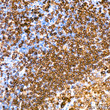| Tissue Specificity | B-cells. |
| Post Translational Modifications | Phosphorylated on tyrosine, serine and threonine residues upon B-cell activation. Phosphorylation of tyrosine residues by Src-family kinases is an early and essential feature of the BCR signaling cascade. The phosphorylated tyrosines serve as docking sites for SH2-domain containing kinases, leading to their activation which in turn leads to phosphorylation of downstream targets. Phosphorylated by LYN. Phosphorylation of serine and threonine residues may prevent subsequent tyrosine phosphorylation. Arginine methylation in the ITAM domain may interfere with the binding of SYK. It promotes signals leading to B-cell differentiation. |
| Function | Required in cooperation with CD79B for initiation of the signal transduction cascade activated by binding of antigen to the B-cell antigen receptor complex (BCR) which leads to internalization of the complex, trafficking to late endosomes and antigen presentation. Also required for BCR surface expression and for efficient differentiation of pro- and pre-B-cells. Stimulates SYK autophosphorylation and activation. Binds to BLNK, bringing BLNK into proximity with SYK and allowing SYK to phosphorylate BLNK. Also interacts with and increases activity of some Src-family tyrosine kinases. Represses BCR signaling during development of immature B-cells. |
| Protein Name | B-Cell Antigen Receptor Complex-Associated Protein Alpha ChainIg-AlphaMb-1 Membrane GlycoproteinMembrane-Bound Immunoglobulin-Associated ProteinSurface Igm-Associated ProteinCd Antigen Cd79a |
| Database Links | Reactome: R-HSA-5690714Reactome: R-HSA-9679191Reactome: R-HSA-983695 |
| Cellular Localisation | Cell MembraneSingle-Pass Type I Membrane ProteinFollowing Antigen BindingThe Bcr Has Been Shown To Translocate From Detergent-Soluble Regions Of The Cell Membrane To Lipid Rafts Although Signal Transduction Through The Complex Can Also Occur Outside Lipid Rafts |
| Alternative Antibody Names | Anti-B-Cell Antigen Receptor Complex-Associated Protein Alpha Chain antibodyAnti-Ig-Alpha antibodyAnti-Mb-1 Membrane Glycoprotein antibodyAnti-Membrane-Bound Immunoglobulin-Associated Protein antibodyAnti-Surface Igm-Associated Protein antibodyAnti-Cd Antigen Cd79a antibodyAnti-CD79A antibodyAnti-IGA antibodyAnti-MB1 antibody |
Information sourced from Uniprot.org












